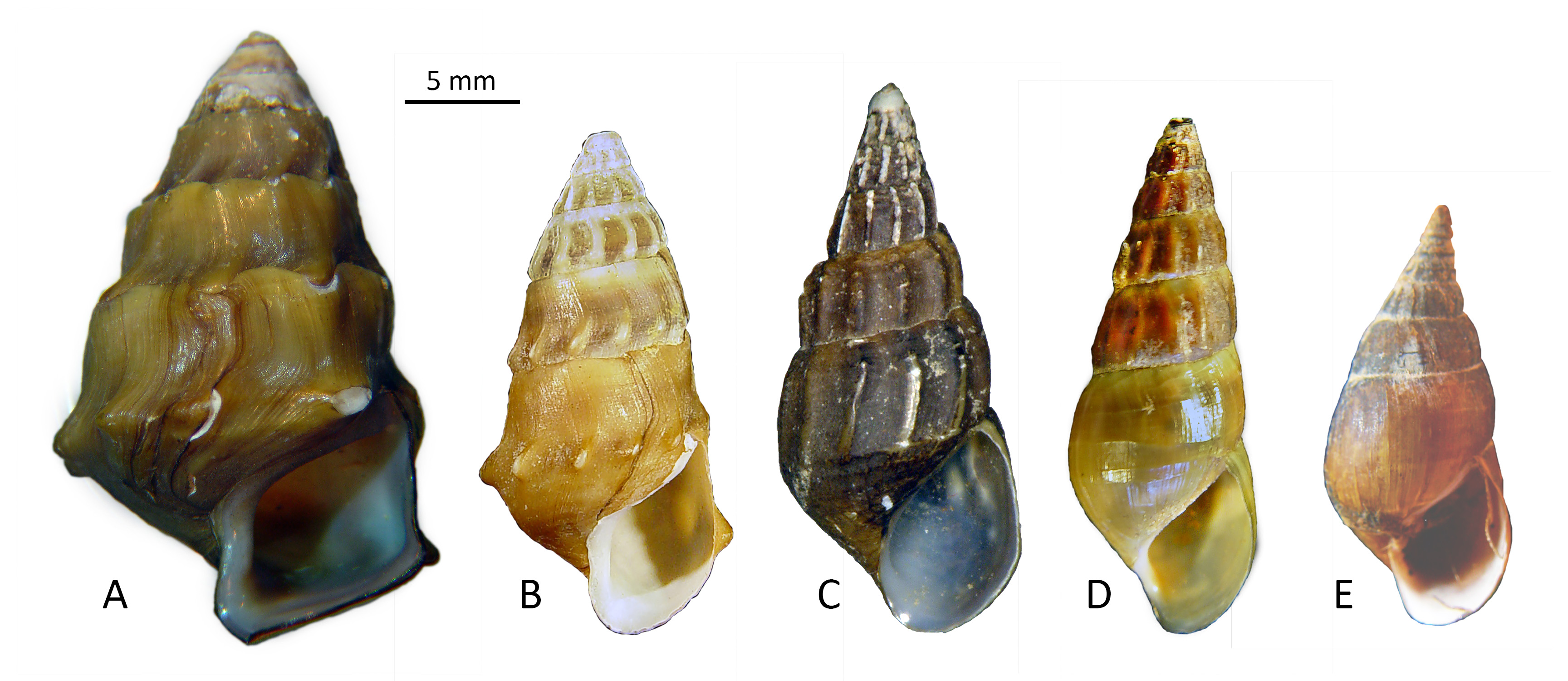Pleurocera alveare
> Habitat & Distribution
The range of P. alveare (in its old sense) was given by Goodrich (1940) as extending from the Green, Wabash, and lower Ohio Rivers through the Cumberland River to the main Tennessee River as far upstream as Muscle Shoals, as well as "streams of North Arkansas and Southern Missouri." Populations seem restricted to larger rivers, reaching maximum abundance on solid substrates.
It is perhaps this latter requirement that is responsible for the apparent rarity of populations we identify as P. laqueata alveare in the muddy and impounded Ohio, Tennessee, and Cumberland Rivers today. Our modern database includes just a few records from the lower Green River and the middle Cumberland drainages, with a single record in the Paint Rock River of North Alabama. Combining the subspecies alveare together with typical P. laqueata laqueata and hybrid P. laqueata castanea for analysis, their FWGNA incidence rank is I-5.
> Ecology & Life History
Grazing by populations of pleurocerids can have a significant effect on energy flow in small streams (Dillon 2000: 86 - 91, see also Dillon & Davis 1991).
Like other pleurocerids, P. laqueata is dioecious, eggs being deposited on hard substrates from spring to mid-summer. Eggs are spirally arranged in masses of 2-15 or more, with a tough, membranous outer covering to which sand grains typically adhere (Smith 1980, Jokinen 1992). Although we are unaware of any study specifically directed toward the life history of P. laqueata, it seems reasonable to expect that two years will be required for maturity, and that several years of iteroparous reproduction can be expected thereafter, as is the case for pleurocerids generally (Dazo 1965). This is life cycle Hi of Dillon (2000: 156 - 162).
> Taxonomy & Systematics
Pleurocera laqueata is is another North American pleurocerid species demonstrating protean variability in shell morphology, named and re-named dozens of times in the nineteenth and early twentieth centuries. There is also good evidence that P. laqueata hybridizes with both P. troostiana and P. simplex, yielding a wealth of hybrid shell variants as well. Goodrich (1940) recognized ten valid species and six valid subspecies in his group of Goniobasis laqueata, along with no fewer than 55 synonyms, plus another nine synonyms in his group of Pleurocera alveare.
More recently it has become clear that the distinction Goodrich and all previous authorities made between the former genera Pleurocera and Goniobasis (or "Elimia") is due to cryptic phenotypic plasticity (Dillon 2011, 2014; Dillon et al. 2013). This has led to the realization that populations previously identified as "Pleurocera alveare" are likely downstream ecophenotypic morphs of P. laqueata. See my essays of 23Mar11 and 8Aug18 from the links below for more.
> Maps and Supplementary Resources
- Pleurocera laqueata in the drainage of The Ohio (2019)
- Distribution in the Tennessee/Cumberland (2022)
- Cryptic phenotypic plasticity in P. laqueata. (A)
Historic specimen of P.
laqueata alveare from Kentucky. (B) P. laqueata alveare
from Dale Hollow Lake, TN. (C) P. laqueata laqueata
from the Duck River, TN. (D) P. laqueata laqueata
from the Nolin River, KY. (E) Hybrid P. laqueata castanea from Roberston Co, TN.

> Essays
- Taxonomic controversy has surrounded the generic nomina Pleurocera, Goniobasis, and Elimia for many years. The best entry into the subject would be my essay of 23Mar11, entitled Goodbye Goniobasis, Farewell Elimia. Links are available from that essay to older resources.
- More recent documentation of cryptic phenotypic plasticity in the North American Pleuroceridae is offered in my essays of 3June13 Pleurocera acuta is Pleurocera canaliculata, 18June13 Pleurocera canaliculata and the process of scientific discovery, and 11July14 Elimia livescens and Lithasia obovata are Pleurocera semicarinata.
- I reviewed the evidence that P. alveare may be a downstream ecophenotypic morph of P. laqueata in my essay of 8Aug18, Pleurocera alveare: Another case of CPP?
- See my essay of 15Oct24 for shell morphometric evidence of Widespread hybridization between P. laqueata and P. troostiana in streams of the Tennessee/Cumberland.
- And in my follow-up essay of 12Nov24, I generalized evidence of hybridization between populations of P. laqueata and both P. troostiana and P. simplex to suggest Reticulate evolution in the North American Pleuroceridae. That November essay also featured additional systematic, taxonomic, and biological backround about P. laqueata castanea.
> References
Dazo, B. C. (1965) The
morphology and natural history of Pleurocera
acuta and Goniobasis
livescens (Gastropoda: Cerithiacea: Pleuroceridae).
Malacologia 3: 1 - 80.
Dillon, R. T., Jr. (2000)
The Ecology of Freshwater Molluscs. Cambridge, Cambridge University
Press. 509 pp.
Dillon, R. T., Jr. (2011)
Robust shell phenotype is a local response to stream size in the genus Pleurocera.
Malacologia 53: 265-277. [pdf]
Dillon, R. T.,
Jr. (2014) Cryptic phenotypic plasticity in
populations of the North American freshwater gastropod, Pleurocera semicarinata.
Zoological Studies 53:31. [html] [pdf]
Dillon, R. T. Jr.,
& K. B. Davis (1991)
The diatoms ingested by freshwater snails: temporal, spatial, and
interspecific variation. Hydrobiologia 210: 233-242.
Dillon, R. T., Jr., S. J.
Jacquemin & M. Pyron (2013) Cryptic phenotypic
plasticity in populations of the freshwater prosobranch snail, Pleurocera canaliculata.
Hydrobiologia 709: 117-127. [html] [pdf]
Goodrich, C. (1940)
The Pleuroceridae of the Ohio River drainage system. Occas.
Pprs. Mus. Zool. Univ. Mich., 417: 1-21.
Jokinen, E.H. (1992)
The freshwater snails of New York State. New York State Museum
Biological Survey, New York State Museum Bulletin 482.
Smith, D.G.
(1980) Goniobasis
virginica (Gastropoda: Pleuroceridae) in the Connecticut
River USA. Nautilus 94:50-54.








